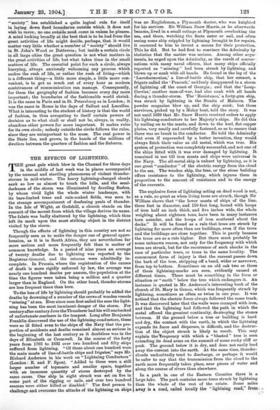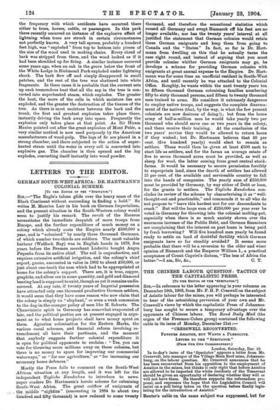Though the effects of lightning in this country are not
so frequently seen as to make the danger one of general appre- hension, as it is in South Africa, they are nevertheless far more serious and more frequently felt than is matter of common knowledge. In a period of nine years an average of twenty deaths due to lightning was reported to the Registrar-General, and the returns were admittedly in- complete. In Prussia, where the registration of the causes of death is more rigidly enforced by law, the average was nearly one hundred deaths per annum, the population at the time the figures were taken being a million and a quarter larger than in England. On the other hand, thunder-storms are less frequent there than here.
To the loss of life by lightning should probably be added the deaths by drowning of a number of the crews of wooden vessels "missing" at sea. Ever since men first sailed the seas the light- ning has been the most imminent danger of the storm. For century after century Jove the Thunderer had his will unchecked of unfortunate mariners in the tempest. Long after Benjamin Franklin discovered the use of the lightning-conductors, these were so ill fitted even to the ships of the Navy that the pro- portion of accidents and deaths remained almost as serious in the beginning of the last century as it doubtless was in the days of Elizabeth or Cromwell. In the course of the forty years from 1793 to 1832 over two hundred and fifty ships suffered from lightning. "Of these about one hundred were the main masts of line-of-battle ships and frigates," says Mr. Richard Anderson in his work on "Lightning Conductors" (London : E. and F. Spon). "Added to these were a still larger number of topmasts and smaller spars, together with an immense quantity of stores destroyed by the same cause. One ship in eight struck was set on fire in some part of the rigging or sails, and over two hundred seamen were either killed or disabled." The first person to challenge and overcome the attacks of the lightning on ships
was an Englishman, a Plymouth doctor, who was knighted for his services. Sir William Snow Harris. as he afterwards became, lived in a small cottage at Plymouth overlooking the sea, and there, watching the fleets enter or sail, and often seeing some ship crippled by lightning brought in for repairs, it occurred to him to invent a means for their protection. This he did. But be had first to convince the Admiralty by statistics that the matter was serious. Among other argu- ments, he urged upon the Admiralty, as the result of conver- sations with many naval officers, that many ships officially reported as " missing " had been struck by lightning, and blown up or sunk with all hands. He found in the log of the Lacedaemonian,' a line-of-battle ship, that her consort, a frigate called the Peacock,' suddenly disappeared in a storm of lightning off the coast of Georgia ; and that the Loup- Cervier,' another man-of-war, had also suuk with all hands during a thunder-storm. The Resistance,' a forty-gun ship, was struck by lightning in the Straits of Malacca. The powder magazine blew up, and the ship sunk; but three survivors, picked up by a Malay boat, told the story. It was not until 1839 that Mr. Snow Harris received orders to apply his lightning-conductors to her Majesty's ships. He did this by nailing on to the masts, and down to the keel, flat copper plates, very neatly and carefully fastened, so as to ensure that there was no break in the conductor. He told the Admiralty that even if superseded by a better invention, they would always fetch their value as old metal, which was true. His system of protection was completely successful, and not one of the ships fitted with it was ever damaged by lightning. It remained in use till iron masts and ships were universal in the Navy. The all-metal ship is unhurt by lightning, as it is one great "conductor" of the electric energy from the cloud to the sea. The wooden ship, the tree, or the stone building offers resistance to the lightning, which injures them in proportion to the amount of resistance and to the energy of the currents.
The explosive force of lightning acting on dead wood is not, as a rule, so great as when living trees are struck, though Sir William shows that "the lower masts of ships of the line, three feet in diameter, and 110 feet long, bound with hoops of iron half an inch thick, and five inches wide, the whole weighing about eighteen tons, have been in many instances torn asunder, and the hoops of iron scattered about the decks." It will be found as a rule that trees are struck by lightning far more often than are buildings, even if the trees and the buildings are close together. This is partly because the trees are as a rule higher. But there must probably be some unknown reason, not only for the frequency with which trees are struck, but for the recurrence of such shocks in the case of particular trees, or trees in the same locality. The commonest form of injury is that the current passes down the bark of the tree, stripping off a band, wider or narrower, from top to bottom. Sometimes on an old oak two or three of these lightning-marks are seen, evidently caused at different times. There must be something in the form or situation or " earth " below the tree which endangers it. An instance is quoted in Mr. Anderson's interesting book of the church of St. Mary in Genoa, which was frequently struck by lightning, sometimes as often as twice in one year. It was noticed that the electric force always followed the same track. It was discovered later that the walls were cramped with iron, and that the lightning had followed the path in which the metal offered the greatest continuity, destroying the stones between. If the ground below a tree or building is hard and dry, the contact with the earth, in which the lightning expends its force and disperses, is difficult, and the destruc- tion of the object struck is likely to result. This may explain thelrequency with which a " blasted " tree is seen extending its dead arms on the summit of some rocky cliff or peak. The ground below it is dry, and does not easily lead away the current into the earth. At the same time, thunder- clouds undoubtedly tend to discharge, or perhaps it would be safer to say that the transmission from the cloud to the earth more frequently takes place, near pieces of water and along the course of rivers than elsewhere.
In a park in one of the Eastern Counties there is a large lake. The park contains more trees struck by lightning than the whole of the rest of the estate. Some miles away is a, road, called locally the "lightning road," from , the frequency with which accidents have occurred there either to trees, horses, cattle, or passengers. In this park there recently occurred an instance of the explosive effect of lightning when trees are struck in certain circumstances not perfectly known. A very tall spruce, probably a hundred feet high, was " exploded " from top to bottom into pieces of the size of the wood used in making chairs. Every shred of bark was stripped from them, and the wood looked as if it had been shredded up for firing. A similar instance occurred some years ago, when an oak in the grove below the front of the White Lodge in Richmond Park exploded under lightning shock. The bark flew off and simply disappeared in small patches, and the rest of the tree was shattered into white fragments. In these cases it is probable that the current sets up such tremendous beat that all the sap in the tree is con- verted into superheated steam, which explodes. The greater the heat, the more of the cells in which moisture lies are exploded, and the greater the destruction of the tissues of the tree. As there is most moisture between the bark and the trunk, the first and greatest explosion takes place there, instantly driving the bark away into space. Frequently the explosion only takes place at that point. As Sir Hiram Maxim pointed out after the great explosion of Mont Pelee, a very similar method is now used purposely by the American manufacturers of wood-pulp. The logs of fir are placed in a strong chamber, and there subjected to the action of super- heated steam until the water in every cell is converted into explosive gas. The chamber is then opened and the log explodes, converting itself instantly into wood powder.











































 Previous page
Previous page